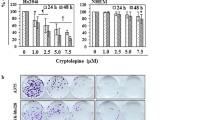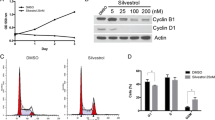Abstract
Purpose
ASNA1 is homologous to E. coli ArsA, a well characterized ATPase involved in efflux of arsenite and antimonite. Cells resistant to arsenite and antimonite are cross-resistant to the chemotherapeutic drug cisplatin. ASNA1 is also an essential ATPase for the insertion of tail-anchored proteins into ER membranes and a novel regulator of insulin secretion. The aim of this study was to determine if altered ASNA1 levels influenced growth and sensitivity to arsenite and cisplatin in human melanoma cells.
Methods
Cultured melanoma T289 cells were transfected with plasmids containing sense or antisense ASNA1. Cells were exposed to cisplatin, arsenite and zinc. Cell growth and chemosensitivity were evaluated by the MTT assay and apoptosis by a TUNEL assay.
Results
ASNA1 expression was necessary for growth. T289 clones with decreased ASNA1 expression exhibited 51 ± 5% longer doubling times than wildtype T289 (P = 0.0091). After exposure to cisplatin, ASNA1 downregulated cells displayed a significant increase in apoptosis. The cisplatin IC50 in ASNA1 underexpressing cells was 41.7 ± 1.8% compared to wildtype (P = 0.00097) and the arsenite IC50 was 59.9 ± 3.2% of wildtype IC50 (P = 0.0067).
Conclusions
Reduced ASNA1 expression is associated with significant inhibition of cell growth, increased apoptosis and increased sensitivity to cisplatin and arsenite.




Similar content being viewed by others
References
Adams JM, Cory S (2007) The Bcl-2 apoptotic switch in cancer development and therapy. Oncogene 26:1324–37
Andrews PA, Howell SB (1990) Cellular pharmacology of cisplatin: perspectives on mechanisms of acquired resistance. Cancer Cells 2:35–43
Andrews PA, Jones JA, Varki NM, Howell SB (1990) Rapid emergence of acquired cis-diamminedichloroplatinum(II) resistance in an in vivo model of human ovarian carcinoma. Cancer Commun 2:93–100
Auld KL, Hitchcock AL, Doherty HK, Frietze S, Huang LS, Silver PA (2006) The conserved ATPase Get3/Arr4 modulates the activity of membrane-associated proteins in Saccharomyces cerevisiae. Genetics 174:215–227
Bhattacharjee H, Ho YS, Rosen BP (2001) Genomic organization and chromosomal localization of the Asna1 gene, a mouse homologue of a bacterial arsenic-translocating ATPase gene. Gene 272:291–299
Borgese N, Colombo S, Pedrazzini E (2003) The tale of tail-anchored proteins: coming from the cytosol and looking for a membrane. J Cell Biol 161:1013–1019
Chen YA, Scheller RH (2001) SNARE-mediated membrane fusion. Nat Rev Mol Cell Biol 2:98–106
Kao G, Nordenson C, Still M, Ronnlund A, Tuck S, Naredi P (2007) ASNA–1 Positively regulates insulin secretion in c elegans and mammalian cells. Cell 128:577–587
Koonin EV (1993) A superfamily of ATPases with diverse functions containing either classical or deviant ATP-binding motif. J Mol Biol 229:1165–1174
Kornmann M, Arber N, Korc M (1998) Inhibition of basal and mitogen-stimulated pancreatic cancer cell growth by cyclin D1 antisense is associated with loss of tumorigenicity and potentiation of cytotoxicity to cisplatinum. J Clin Invest 101:344–352
Kurdi-Haidar B, Aebi S, Heath D, Enns RE, Naredi P, Hom DK, Howell SB (1996) Isolation of the ATP-binding human homolog of the arsA component of the bacterial arsenite transporter. Genomics 36:486–491
Kurdi-Haidar B, Heath D, Aebi S, Howell SB (1998) Biochemical characterization of the human arsenite-stimulated ATPase (hASNA-I). J Biol Chem 273:22173–22176
Kurdi-Haidar B, Heath D, Naredi P, Varki N, Howell SB (1998) Immunohistochemical analysis of the distribution of the human ATPase (hASNA-I) in normal tissues and its overexpression in breast adenomas and carcinomas. J Histochem Cytochem 46:1243–1248
Kurdi-Haidar B, Hom DK, Flittner DE, Heath D, Fink L, Naredi P, Howell SB (1998) Dual cytoplasmic and nuclear distribution of the novel arsenite-stimulated human ATPase (hASNA-I). J Cell Biochem 71:1–10
McClay EF, Jones JA, Winski PJ, Albright KD, Christen RD, Howell SB (1996) Determinants of tamoxifen sensitivity control the nature of the synergistic interaction between tamoxifen and cisplatin. Cancer Res 56:3993–3997
Mosmann T (1983) Rapid colorimetric assay for cellular growth and survival: application to proliferation and cytotoxicity assays. J Immunol Methods 65:55–63
Naredi P, Heath DD, Enns RE, Howell SB (1994) Cross-resistance between cisplatin and antimony in a human ovarian carcinoma cell line. Cancer Res 54:6464–6468
Naredi P, Heath DD, Enns RE, Howell SB (1995) Cross-resistance between cisplatin, antimony potassium tartrate, and arsenite in human tumor cells. J Clin Invest 95:1193–1198
Rosen BP, Weigel U, Karkaria C, Gangola P (1988) Molecular characterization of an anion pump. The arsA gene product is an arsenite(antimonate)-stimulated ATPase. J Biol Chem 263:3067–3070
Safaei R, Katano K, Larson BJ, Samimi G, Holzer AK, Naerdemann W, Tomioka M, Goodman M, Howell SB (2005) Intracellular localization and trafficking of fluorescein-labeled cisplatin in human ovarian carcinoma cells. Clin Cancer Res 11:756–767
Safaei R, Larson BJ, Cheng TC, Gibson MA, Otani S, Naerdemann W, Howell SB (2005) Abnormal lysosomal trafficking and enhanced exosomal export of cisplatin in drug-resistant human ovarian carcinoma cells. Mol Cancer Ther 4:1595–1604
Schuldiner M, Collins SR, Thompson NJ, Denic V, Bhamidipati A, Punna T, Ihmels J, Andrews B, Boone C, Greenblatt JF, Weissman JS, Krogan NJ (2005) Exploration of the function and organization of the yeast early secretory pathway through an epistatic miniarray profile. Cell 123:507–519
Shen J, Hsu CM, Kang BK, Rosen BP, Bhattacharjee H (2003) The Saccharomyces cerevisiae Arr4p is involved in metal and heat tolerance. Biometals 16:369–378
Siddik ZH (2003) Cisplatin: mode of cytotoxic action and molecular basis of resistance. Oncogene 22:7265–7279
Stefanovic S, Hegde RS (2007) Identification of a targeting factor for posttranslational membrane protein insertion into the ER. Cell 128:1147–1159
Taetle R, Jones OW, Honeysett JM, Abramson I, Bradshaw C, Reid S (1987) Use of nude mouse xenografts as preclinical screens characterization of xenograft-derived melanoma cell lines. Cancer 60:1836–1841
Tisa LS, Rosen BP (1990) Molecular characterization of an anion pump. The ArsB protein is the membrane anchor for the ArsA protein. J Biol Chem 265:190–194
Tseng YY, Yu CW, Liao VH (2007) Caenorhabditis elegans expresses a functional ArsA. FEBS J 274:2566–2572
Acknowledgments
The authors are grateful to A. Berglund and C. Lundin for technical assistance. We also thank Prof SB Howell (Department of Medicine and the Moores UCSD Cancer Center, University of California, San Diego) for helpful discussions, expert advice and for providing the T289 and T289/DDP cells. This work was supported by The Cancer Research Foundation Norrland, Lion’s Cancer Research Foundation at Umeå University, J C Kempe Memorial Foundation Scholarship Fund, The County Council of Västernorrland and Västerbotten County Council (ALF-means).
Author information
Authors and Affiliations
Corresponding author
Rights and permissions
About this article
Cite this article
Hemmingsson, O., Zhang, Y., Still, M. et al. ASNA1, an ATPase targeting tail-anchored proteins, regulates melanoma cell growth and sensitivity to cisplatin and arsenite. Cancer Chemother Pharmacol 63, 491–499 (2009). https://doi.org/10.1007/s00280-008-0762-2
Received:
Accepted:
Published:
Issue Date:
DOI: https://doi.org/10.1007/s00280-008-0762-2




